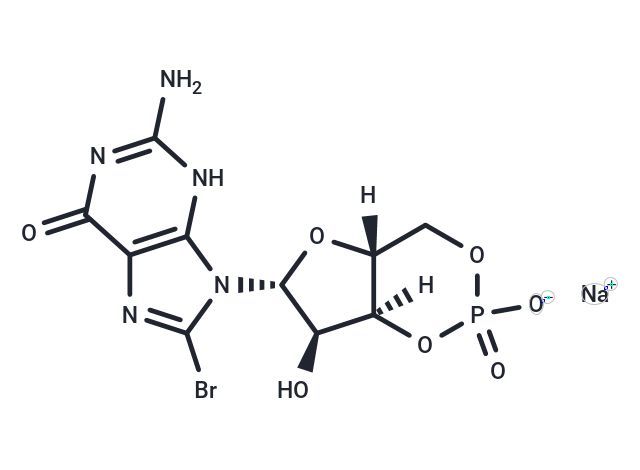Shopping Cart
Remove All Your shopping cart is currently empty
Your shopping cart is currently empty
8-Bromo-cGMP sodium is a PKG activator, a membrane-permeable analog of cGMP. 8-Bromo-cGMP sodium has pain-relieving and vasodilatory effects, significantly inhibits Ca2+ macroscopic currents, and inhibits high K+-stimulated insulin release.

| Pack Size | Price | USA Warehouse | Global Warehouse | Quantity |
|---|---|---|---|---|
| 2 mg | $35 | In Stock | In Stock | |
| 5 mg | $55 | In Stock | In Stock | |
| 10 mg | $89 | In Stock | In Stock | |
| 25 mg | $162 | In Stock | In Stock | |
| 50 mg | Preferential | 6-8 weeks | 6-8 weeks |
| Description | 8-Bromo-cGMP sodium is a PKG activator, a membrane-permeable analog of cGMP. 8-Bromo-cGMP sodium has pain-relieving and vasodilatory effects, significantly inhibits Ca2+ macroscopic currents, and inhibits high K+-stimulated insulin release. |
| In vitro | 8-Bromo-cGMP sodium (1 µM-0.1 mM) can inhibit acetylcholine-induced increases in intracellular calcium concentrations.[1] 8-Bromo-cGMP sodium (1-100 μM; 16 h) induces the synthesis of HO-1 protein in a concentration-dependent fashion.[2] 8-Bromo-cGMP sodium (1-100 μM; 8 h) increases the resistance of LLC-PK1 cells to CsA toxicity in concentration-dependently.[2] |
| In vivo | 8-Bromo-cGMP sodium (0.3, 1, 3 nM; intrathecal administration; 10 min before the test; male ICR mice) significantly increases tail-flick latency in Vincristine-treated mice to the levels observed in vehicle-treated naive mice in a dose-dependent manner.[3] Additionally, 8-Bromo-cGMP sodium (10 mg/kg; iv; single dose) induces vasodilator responses in WT littermates and eNOS-Tg mice in the C57BL/6 background (19-35 g).[4] |
| Molecular Weight | 446.09 |
| Formula | C10H10BrN5NaO7P |
| Cas No. | 51116-01-9 |
| Smiles | BrC1=NC(C(N=C(N2)N)=O)=C2N1[C@H]3[C@@H]([C@@]4([H])[C@](COP([O-])(O4)=O)([H])O3)O.[Na+] |
| Relative Density. | 2.96 g/cm3 |
| Storage | Powder: -20°C for 3 years | In solvent: -80°C for 1 year | Shipping with blue ice/Shipping at ambient temperature. | |||||||||||||||||||||||||||||||||||
| Solubility Information | H2O: 101 mg/mL (226.41 mM), Sonication is recommended. | |||||||||||||||||||||||||||||||||||
Solution Preparation Table | ||||||||||||||||||||||||||||||||||||
H2O
| ||||||||||||||||||||||||||||||||||||
| Size | Quantity | Unit Price | Amount | Operation |
|---|

Copyright © 2015-2026 TargetMol Chemicals Inc. All Rights Reserved.